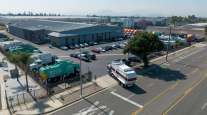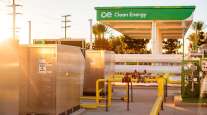Kenworth Offers Test Drives of New Natural Gas Vehicles
This story appears in the July 30 print edition of Transport Topics. Click here to subscribe today.
KIRKLAND, Wash. — Kenworth Truck Co. continued its push into the natural gas market, providing journalists and customers an opportunity earlier this month to test multiple models with engines that run on the fuel that’s garnering significant attention from the trucking industry.
A July 19 media event included the first formal test drives of a Kenworth model T660 featuring a Cummins Westport ISX12G compressed natural gas engine, as well as the T440 truck with a Cummins Westport ISL-G liquefied natural gas engine.
Speaking at a press event the next day at Kenworth’s headquarters here, Andy Douglas, national sales manager for specialty markets, cited a number of industry studies suggesting that natural gas could account for as many as one in 10 heavy-duty trucks being produced in the United States by 2016.
While suggesting those figures could prove to be a little too ambitious, he said natural gas “demand has never been higher.”
In all, eight different trucks were available for testing at the Paccar Technical Center in Mount Vernon, Wash., about 60 miles from Seattle. Most of the trucks were in final testing and would soon be delivered to customers.
Included were T680 day cab and sleeper cab with Paccar MX diesel engines, which the company unveiled early this year at the Mid-America Trucking Show and announced in late May had started production at its plant in Chillicothe, Ohio (6-4, p. 12).
Paccar Inc. is the parent of Kenworth and Peterbilt Motors Co.
In the days prior to the press event, Douglas and Preston Feight, assistant general manager for sales and marketing, said Kenworth had hosted dozens of current and potential customers, providing them a similar opportunity to test-drive the different engines.
Several major natural gas suppliers also were included, providing a direct forum for them to share their infrastructure plans with trucking fleets.
Douglas said much of his initial interaction with fleets interested in natural gas involves explaining the differences between CNG and LNG.
For example, while CNG currently has a greater infrastructure and is less expensive, the fuel tanks tend to be heavier and more costly.
Conversely, while LNG has more range than CNG, it needs to be burned much more quickly or it can “boil off,” Douglas said.
He said determining what fuels are available in a fleet’s operating area and the distance the trucks normally travel are the two factors that need to be addressed before determining if either alternative fuel makes sense yet.
When asked about the overall U.S. and Canadian truck market, Feight said Kenworth was still expecting sales to total between 215,000 and 240,000 for all of 2012.
However, he acknowledged it was appearing more likely sales would trend to the lower end of that range, as economic uncertainty ahead of the presidential election this November would probably extend the traditional summer slowdown of new orders into the fall.
“At the moment, it is hard to see sales reaching 240,000,” Feight said July 20. “It would take one heck of a fourth quarter.”
In its second-quarter earnings release, issued the following week after the Kenworth event here, Paccar lowered its 2012 sales projection for all makes to between 210,000 and 230,000, compared with 197,000 vehicles a year earlier.
Feight was quick to point out that the sales projections are still well above the past several years. Class 8 sales in the United States, bottomed out at 94,798 in 2009, before climbing to just over 107,152 in 2010, according to data from Wardsauto.com.
“Two-hundred fifteen thousand would not be a bad year from the industry’s standpoint,” Feight said.




